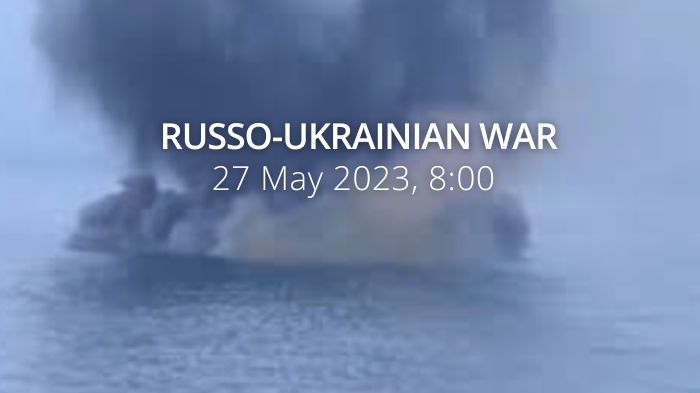Russia suspends Black Sea grain deal . A section of the Crimean bridge fell after a night strike. Russia launches new offensive on eastern front, Ukraine’s top general says.
Daily overview — Summary report, July 17
The General Staff’s operational update regarding the Russian invasion as of 18.00 pm, July 17, 2023 is in the dropdown menu below:
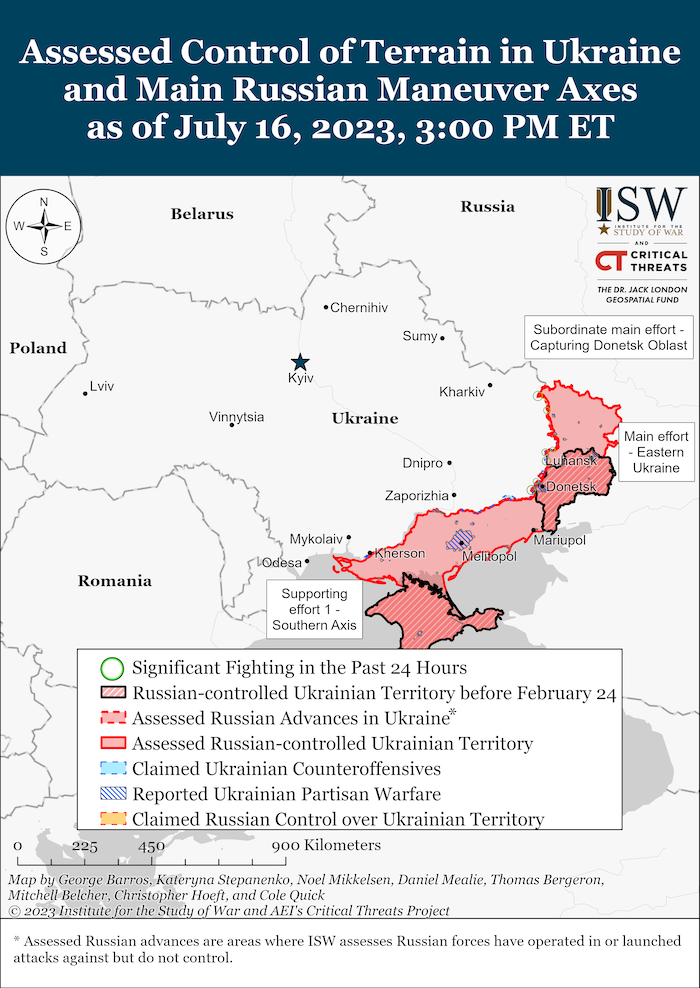

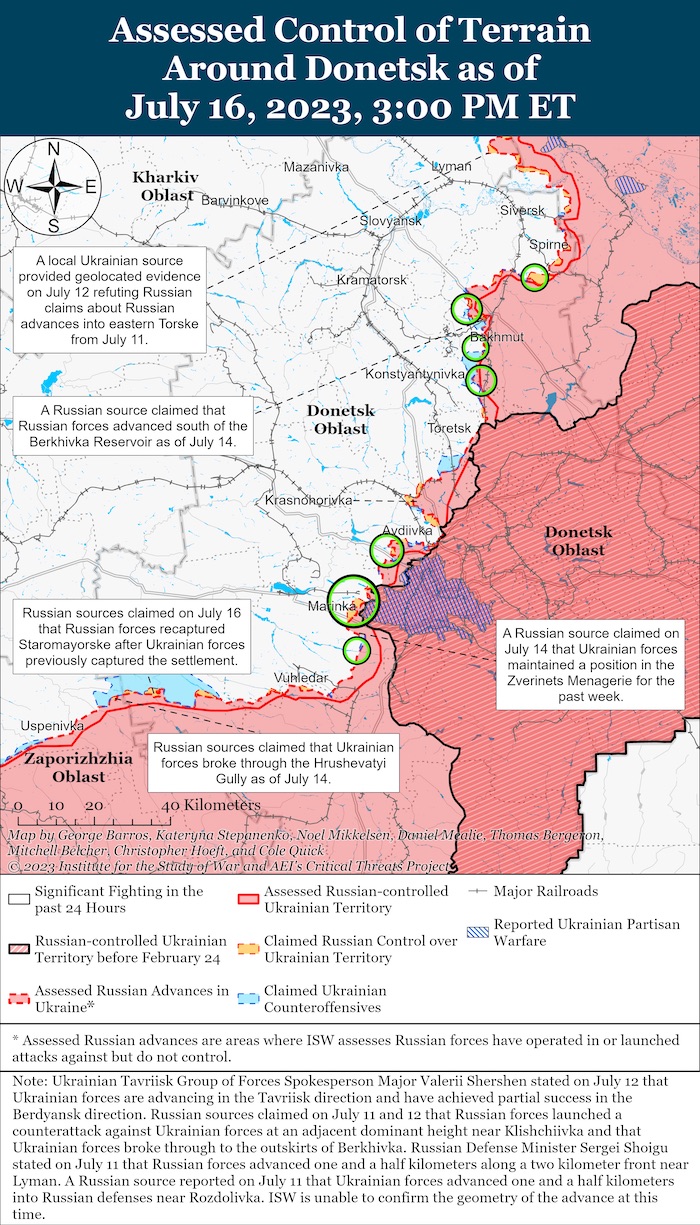
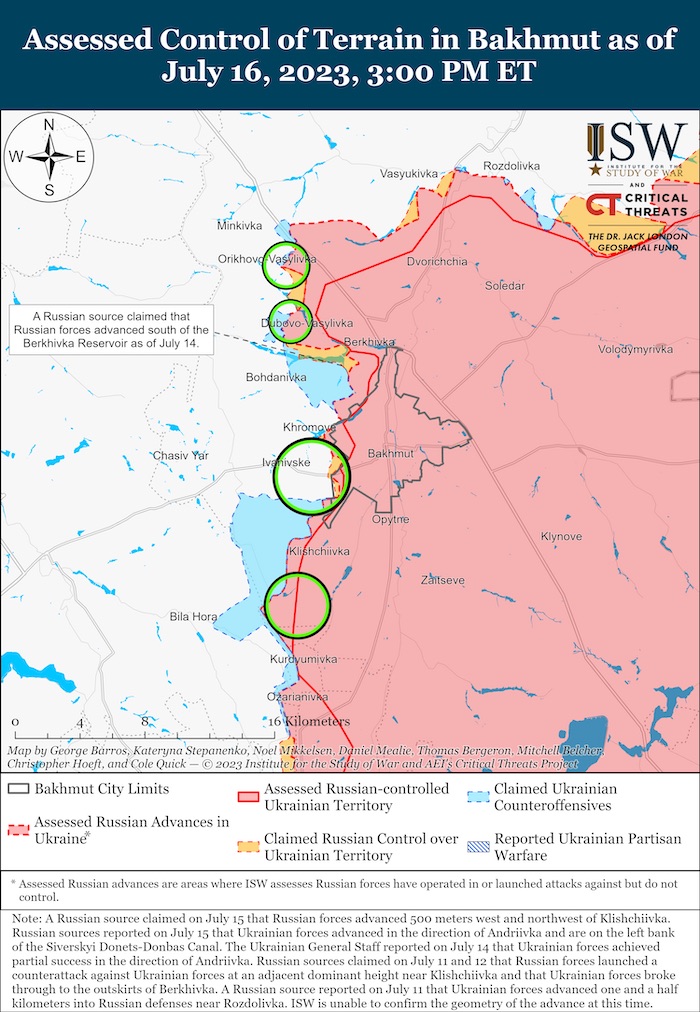
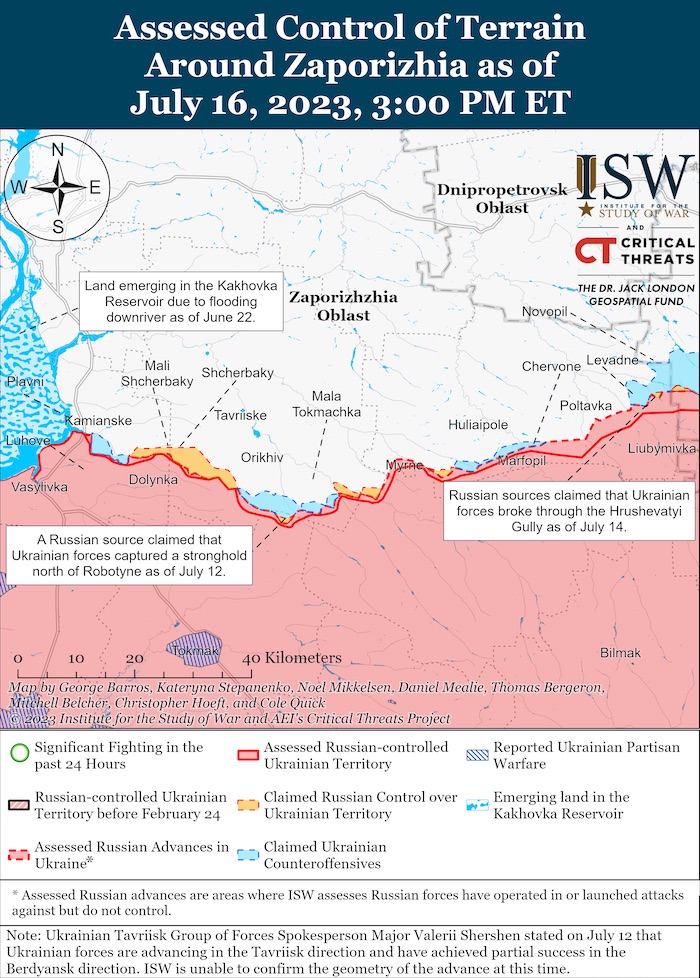
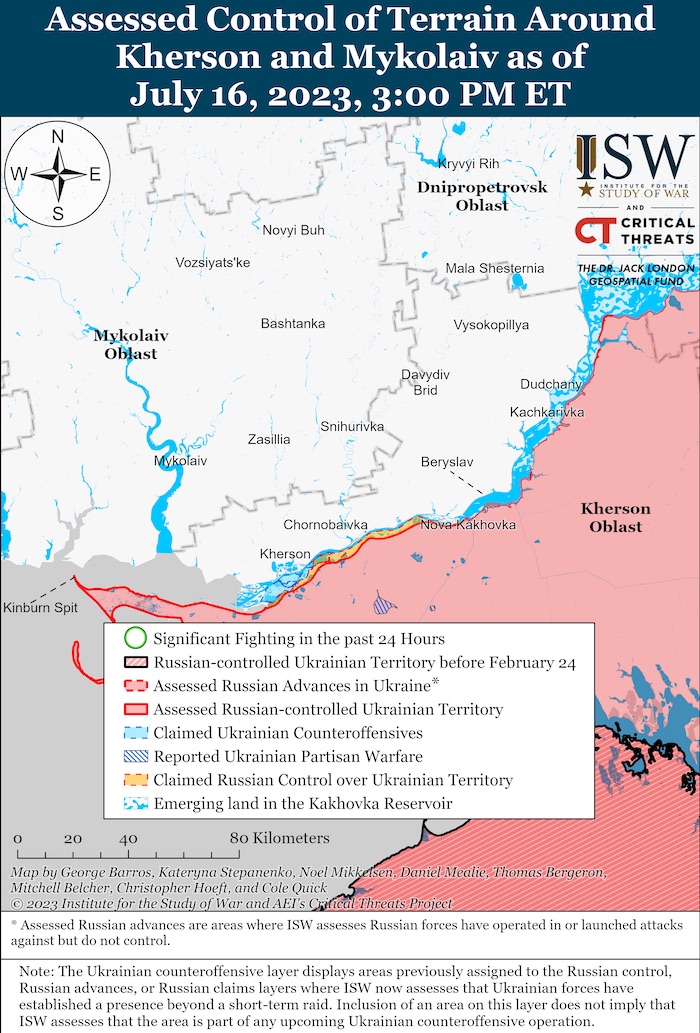
Military Updates
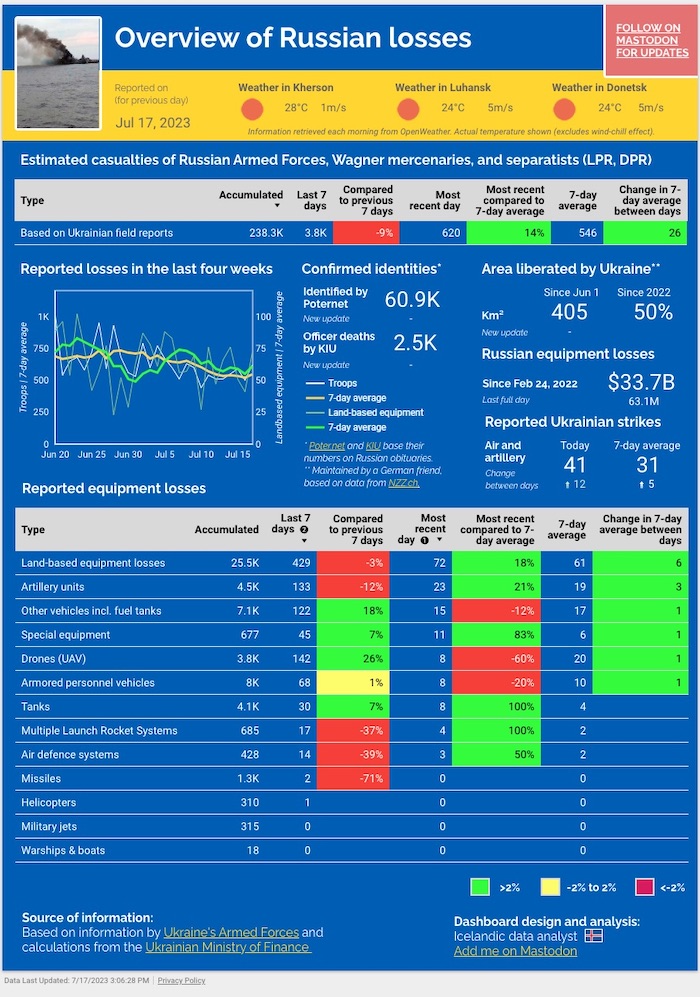
Russia amasses over 100,000 troops for offensive on eastern front, Ukrainian military spox says. Ukraine faces a massive Russian threat in the Lyman-Kupiansk direction on the eastern front, where Russia deployed over 100,000 troops, 900 tanks, and 370 multiple rocket launchers (MLRS), Colonel Serhii Cherevatyi, spokesman for the Eastern Group of Ukraine’s Armed Forces, said during the national news telethon, Ukrainska Pravda reported. Ukraine’s eastern front is threatened by Russia’s massive buildup of troops in the Lyman-Kupiansk area in Donetsk and Kharkiv oblasts, according to Colonel Serhii Cherevatyi.
Russia launches new offensive on eastern front, Ukraine’s top general says. Russia deploys additional forces to the Bakhmut sector (Donetsk Oblast) and Kupiansk sector (Kharkiv Oblast) to mount an offensive and regain the initiative on the eastern front, according to Colonel General Oleksandr Syrskyi, the commander of the Ukrainian Ground Forces. The operational situation in the eastern sector, which includes Kharkiv, Luhansk, and Donetsk oblasts of Ukraine, remains challenging for the Ukrainian Army, Colonel General Oleksandr Syrskyi reported on 17 July.
Sacked Russian general reveals fatal flaw in Russia’s artillery strategy – British intel. Sacked Russian top general exposed the counter-battery problem for the Russian army in Ukraine, British intelligence reported in its daily update on the Russo-Ukrainian war on 17 July. After being sacked as commander of Russia’s 58th Combined Arms Army in Ukraine, General Major Ivan Popov complained about the lack of counter-battery provision for the Russian army on the front line in southern Ukraine, where his troops operated, according to British intelligence.
According to British Defence Intelligence, (last 48 hours):
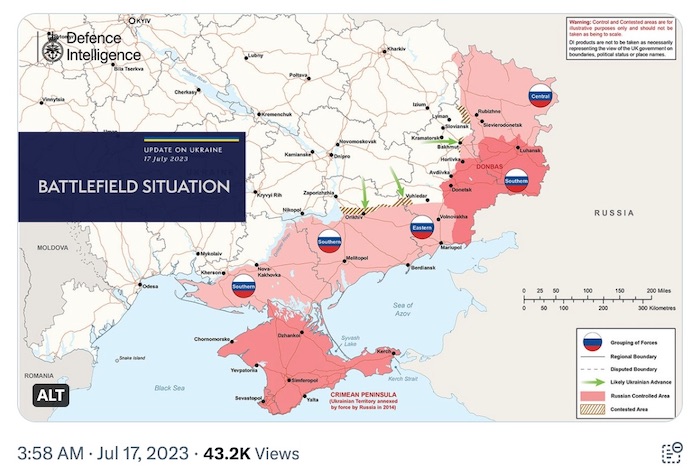
- After being sacked as commander of Russia’s 58th Combined Arms Army (58 CAA) in Ukraine, General-Major Ivan Popov claimed that one of his key complaints had been about the lack of counter battery provision.
- Russian ground forces survivability relies on effectively detecting Ukrainian artillery and striking against it, often with its force’s own artillery. A key component of this approach is counter-battery radars, which allow commanders to rapidly locate enemy gun lines.
- Russia is suffering from a worsening shortage of counter-battery radars, especially its modern ZOOPARK-1M. Only a handful of the originally deployed ZOOPARK fleet are likely to remain operational in Ukraine.
- Open-source footage showed another ZOOPARK being destroyed near the 58 CAA’s area in early July 2023. The priority Popov apparently gave to this problem highlights the continued centrality of artillery in the war.
Losses of the Russian army
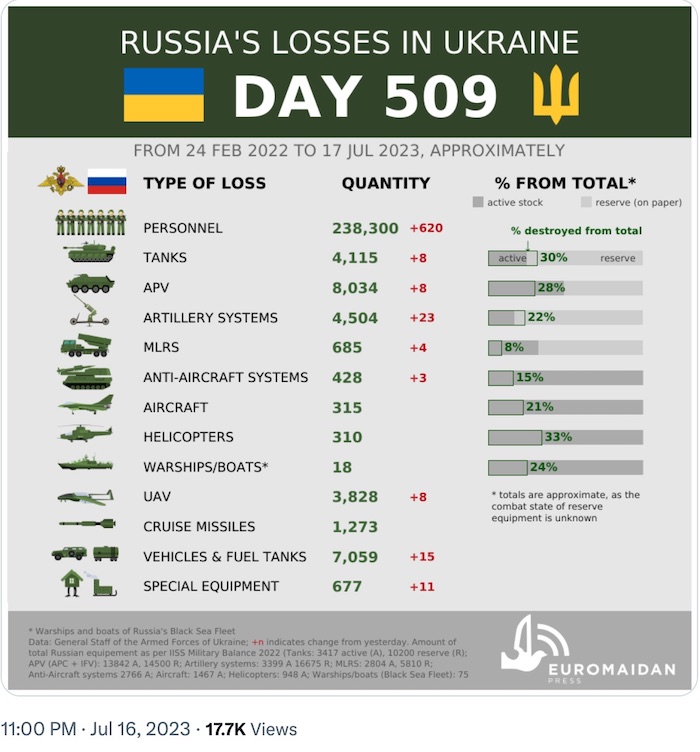
Humanitarian
Remembering the tragedy: 9 years since MH17 was shot down over Ukraine. On July 17, 9 years ago, a BUK missile system, transported from Russia to a field in Eastern Ukraine, shot down Malaysian Airlines flight MH17. Ukrainian Intelligence honors the memory of 298 people from 11 countries killed by Russia. The plane was flying from Amsterdam to Malaysia when it was hit by a surface-to-air missile over an area controlled by pro-Russian separatists.
Russians strike Kharkiv thrice in 24 hours, killing one, injuring four. On 16 July, Russian troops attacked Kharkiv three times with S-300 missiles, killing one civilian and injuring four.At around 2 a.m., Russians launched four S-300 missiles at Kharkiv. Two missiles exploded in the air, while the other two hit a stadium and a road, damaging a four-story apartment building and civilian cars, Kharkiv National Police reported.
Famous Ukrainian filmmaker was wounded on the front second time in a week, says “Bradley saved our lives”. Oleh Sentsov, a Ukrainian filmmaker and writer from Crimea, who spent five years as a political prisoner in Russia, was wounded on the frontline today, on 17 July 2023. He said the US-supplied Bradley armored vehicle saved the crew’s lives under artillery shelling. “The week was not set. On the first combat sortie after returning, we came under artillery fire during the landing. Bradley saved our lives again. Three injured, mostly shrapnel,” Sentsov wrote.
Environmental
Russia suspends Black Sea grain deal – Kremlin spox Peskov. On 17 July, Kremlin spokesman Dmitry Peskov announced Russia’s suspension of the Black Sea grain agreement, signed in the summer of 2022 to unblock the export of Ukrainian grain. “The agreements ceased to be in force today. Unfortunately, the Russia part has not been fulfilled so far. As soon as the Russian part of the agreements is fulfilled, Russia will immediately return to implementing the deal,” Russian RBC reported, citing Peskov.
Legal
Russia violates Geneva Convention by shelling fire station in northeastern Ukraine. A fire station in Sumy Oblast (northeastern Ukraine) came under fire from Russian troops on 17 July, injuring six firefighters, according to the head of the Sumy Oblast Military Administration, Volodymyr Artiukh. Russian troops used artillery to shell downtown Bilopillia in Sumy Oblast. Two people were killed, Volodymyr Artiukh reported.
Ukraine’s Finance Minister stressed the need to accelerate the confiscation of Russian assets at the G7 meeting. Ukraine’s Finance Minister Serhiy Marchenko discussed ongoing international support for Ukraine with the G7 finance ministers on 15 July 2023. He stressed the need to speed up the process of using frozen Russian assets for rebuilding, especially given the need for extended financial support for Ukraine in 2024. Marchenko noted that tax revenues in the first half of 2023 had exceeded forecasts, with customs payments up 68% in the first half of 2023 versus 2022. Since the beginning of the year, Ukraine borrowed $8.2 billion on domestic markets and received $23.6 billion in international financial aid, which helped avoid monetary financing for already seven months.
Support
USAID aid chief allocates over USD 500 mn in assistance during visit to Ukraine. Samantha Power, the US aid chief, pledges over $500 million in humanitarian aid during a visit to Ukraine amidst Russia’s invasion. On July 17 Administrator of the United States Agency for International Development (USAID) Samantha Power visited Ukraine’s capital and announced more than $500 million in humanitarian assistance at the State Emergency Services headquarters in Kyiv, Reuters reports. According to the United Nations’ estimation, about 17 million people need help due to Russia’s invasion.
New Developments
Russia to resume traffic on Crimean bridge in September, one span beyond repair. One span of the damaged Crimean Bridge cannot be restored, according to the Russian news media RIA Novosti, which cited a statement by Russia’s Deputy Prime Minister, Marat Khusnullin, at a meeting with Russian President Vladimir Putin and during Khusnullin’s conversation with journalists. Russia will launch two-way traffic on one side of the Crimean Bridge on 15 September and on the other side in November 2023, according to Marat Khusnullin.
A Russian Su-25 attack aircraft crashed into the sea. A Russian Su-25 attack aircraft crashed in the Russian Krasnodar region. The pilot ejected but didn’t survive after falling into the sea, Russian media reported. Multiple Russian telegram channels shared videos filmed by locals of how the plane crashed into the sea. One of the videos shows how the pilot was subsequently taken from the water, but doctors couldn’t save him.
Assessment
- On the war.
The Institute for te Study of War has made the following assessment as of July 18, 2022:
The Russian MoD has begun to remove commanders from some of the Russian military’s most combat effective units and formations and appears to be accelerating this effort. The recent dismissal of 58th Combined Arms Army Commander (CAA) Colonel General Ivan Popov and the reported dismissal of 106th Guards Airborne (VDV) Division Commander Major General Vladimir Seliverstov prompted further discussions of other alleged recent dismissals and arrests.[1] Russian sources amplified an alleged audio message from personnel of the 7th Guards Mountain VDV Division on July 15 in which the personnel claimed that the Russian military command dismissed 7th VDV Division Commander Major General Alexander Kornev in early July.[2] Russian sources also claimed that Russian authorities arrested 90th Tank Division (Eastern Military District) Commander Major General Ramil Ibatullin as well as two unspecified deputies on an unspecified date.[3] A prominent Kremlin-affiliated milblogger suggested that the Russian military command is also planning to dismiss the 31st VDV Brigade Commander, who is reportedly Colonel Sergei Karasev.[4] Russian sources speculated that the Russian MoD may be preparing to arrest VDV Commander Colonel General Mikhail Teplinsky.[5] ISW has not observed confirmation of Seliverstov’s and Kornev’s dismissals nor of Ibatullin’s arrest, although these claims follow a pattern similar to that of previous claims of command changes that have proven true.[6]
These formations and units are conducting defensive and offensive operations in key sectors of the front in Ukraine. The 58th CAA has conducted a relatively successful defense against Ukrainian counteroffensives in western Zaporizhzhia Oblast, and the 106th Division is committed to defending against Ukrainian assaults on Bakhmut’s northern and southern flanks.[7] ISW has observed elements of the 7th VDV Division deployed to east (left) bank of Kherson Oblast near the Antonivsky Bridge as well as to unspecified areas of western Zaporizhzhia Oblast.[8] Russian milbloggers have claimed that the 31st VDV Brigade is also defending in the Bakhmut direction and that elements of the 90th Tank Division are involved in ongoing limited assaults west of Kreminna, Luhansk Oblast.[9]
The reported dismissal and arrest of commanders leading combat effective units and formations appears to be associated with cases of insubordination. Popov flagrantly attempted to bypass Russian Chief of the General Staff and overall theater commander Army General Valery Gerasimov and directly bring his complaints about the frontline in western Zaporizhzhia to Russian President Vladimir Putin.[10] A prominent Kremlin-affiliated milblogger claimed that Seliverstov’s dismissal was a result of similar insubordination, and Russian sources claimed that Seliverstov had a reputation for speaking up on behalf of his soldiers.[11] Kornev may have voiced criticism of a host of potential issues on behalf of the 7th VDV Division, including the likely failure to be notified beforehand about the Russian destruction of the Nova Kakhovka Hydroelectric Power Station (KHPP) on June 6, reported attritional fighting that failed to eliminate a Ukrainian presence near the Antonivsky Bridge, or conditions in western Zaporizhzhia Oblast similar to those that Popov complained about.[12] Ibatullin’s arrest may be associated with the 90th Tank Division’s resumption of assaults in Luhansk Oblast, where it conducted widespread offensive operations that failed to achieve territorial gains during the Russian 2023 winter offensive campaign.[13] It is unclear why Ibatullin would have been arrested, if, indeed, he was, when the other commanders were reportedly simply removed from their commands.
Insubordination among commanders appears to be spreading to some of their soldiers. Russian milbloggers shared an audio excerpt on July 16 in which the alleged elements of the 7th VDV Division threatened that they would withdraw from their positions in occupied Kherson Oblast if the Russian MoD arrests Teplinsky or threatens his life.[14] The elements of the 7th VDV Division also claimed that they would defend Teplinsky against the Russian MoD and asserted that the high command is targeting Russia’s most combat effective commanders. This audio appeal, if legitimate, is a threat of mass desertion in the face of the enemy on behalf of Teplinsky. Desertion in the face of the enemy is a capital offense in many militaries. The VDV servicemen are blackmailing the Russian MoD to ensure that Teplinsky continues to command troops in Ukraine, despite Teplinsky’s previous affiliation with Wagner Group financier Yevgeny Prigozhin who had led an armed rebellion on June 24 to overthrow Shoigu and Gerasimov.[15]
Teplinsky himself set the precedent for the acts of insubordination that are currently plaguing the Russian MoD. The Russian MoD had previously attempted to launch wide-scale personnel changes within the Russian Armed Forces in January-February 2023 to replace some commanders who had been insubordinate to Shoigu and Gerasimov throughout the invasion. The Russian MoD announced on January 11 that Gerasimov assumed the position of overall theater commander in Ukraine, which upset a group of commanders and Russian irregular formations such as Wagner that supported Gerasimov’s predecessor, Army General Sergei Surovikin.[16] Teplinsky was one of these commanders, and he reportedly resigned on January 12 following an altercation with Gerasimov over Gerasimov’s use of elite VDV forces in human wave attacks.[17] Teplinsky later recorded a video on February 23 in which he confirmed his resignation and implied that Russian commanders in charge of the Russian winter offensive paid for captured villages with soldiers’ lives.[18] Teplinsky’s resignation was not in itself insubordinate--resigning is one of the legal actions an officer can take when he decides that he cannot in good conscience execute a lawful order. Releasing a video criticizing the theater commander, however, was insubordinate and would likely be viewed as conduct prejudicial to good order and discipline, which is a violation of military law in many militaries. Teplinsky’s video likely publicly blamed Gerasimov for Russian casualties during the winter offensive in an effort to undermine his command and set informational conditions to signal the need for Gerasimov’s replacement to Russian President Vladimir Putin.[19] Teplinsky later mobilized support within the VDV veteran community and directly appealed to Putin on March 15 regarding the Russian MoD’s poor treatment of Wagner forces and poor conduct of the Russian war effort in Ukraine.[20] Putin rewarded Teplinsky’s insubordination by reappointing him as the VDV commander on April 1 instead of punishing him for his public actions undermining the theater commander.
Popov’s leaked audio recording demonstrated a striking resemblance to Teplinsky’s appeals as it portrayed Popov’s insubordination as an attempt to improve conditions for 58th CAA’s servicemen. Popov did not claim responsibility for leaking the audio recording, however, he likely intended to evoke similar support for himself as the voice of opposition to the Russian MoD among servicemen and veterans of the 58th CAA. Both Teplinsky and Popov demanded radical changes in the Russian conduct of the war – that, however necessary they might be, are impossible for Gerasimov or Shoigu to execute given Putin’s unrealistic demands for the war effort, constraints on Russian mobilization, and the Russian MoD’s persistent incompetence. Putin reportedly signed a decree deploying Popov to Syria on July 14 on Gerasimov’s recommendation.[21] ISW assessed on April 30 that the Kremlin demoted several commanders by transferring their responsibilities from combat in Ukraine to Syria or Nagorno-Karabakh and that these apparent demotions leave open the possibility that these commanders could return to Putin’s favor.[22]
The Kremlin’s chronic disregard for the Russian chain of command is likely hindering Shoigu and Gerasimov in their attempts to suppress insubordination and establish full control over the Russian military in Ukraine. Putin consistently bypassed or ignored the established chain of command in hopes of securing rapid successes on the battlefield throughout the war, degrading Shoigu’s and Gerasimov’s authority – especially when military failures on the frontlines also eroded their reputations. Putin had cultivated an environment in which military personnel, officials, and even Russian war correspondents bypassed Shoigu and Gerasimov to present Putin their understandings of the current state of the war and recommendations for what to do.[23] It is unusual but not unique for a commander in chief to solicit views on the war from outside experts. It is more problematic, although still not unique, for a commander in chief to solicit the views of subordinates opposed to senior leadership directly. But allowing a quasi-military commander such as Prigozhin to conduct his own campaign parallel but not subordinate to the one being executed by the formal chain of command is extraordinarily unusual and badly corrosive of the authority of the formal military leadership.
Putin also established the Russian MoD as the scapegoat for all Russian military failures, which saddled Shoigu and Gerasimov with a reputation for incompetence and failure that they are unlikely to repair.[24] ISW previously assessed that Putin regularly grants and withdraws his support for different commanders in hopes generating rapid improvements in Russia’s military fortunes but without always doing so formally.[25] Shoigu and Gerasimov likely expected that Putin would restore their full authority over the Russian military’s decision-making processes given their loyalty to him after Wagner’s armed rebellion on June 24. Putin, however, has clearly not done so. He has instead followed his normal pattern of seeking to divert backlash away from himself and rotating commanders instead of outright dismissing them.[26] Intensifying insubordination and widespread outrage in response to the ongoing officer purge may force the Kremlin to reconsider its partial backing for Shoigu and Gerasimov in the wake of Wagner’s rebellion.
The intensifying dynamic of insubordination among Russian commanders in Ukraine may prompt other commanders to oppose the Russian military leadership more overtly. ISW has previously assessed that Teplinsky and Popov have established precedents for Russian military officers to challenge the authority of senior commanders and for to use their responsibility for key sectors of the front to cajole the Kremlin into supporting them.[27] Insubordinate commanders appear to be more actively emulating this approach to achieving their desired aims and are likely aware of the constraints the MoD faces in punishing them. These commanders present themselves as defenders of their soldiers, tapping into longstanding grievances about the war effort that the Kremlin routinely attempts to avoid exacerbating but has been unable or unwilling to address.[28] The Kremlin’s relatively soft reaction to insubordination likely incentivizes strong-willed commanders to engage in these patterns of insubordination, knowing that they offer substantial rewards with relatively low risks. These commanders appear to be deftly drawing a line between themselves and Prigozhin by centering their soldiers in their complaints and avoiding the appearance of promoting their personal ambitions, which had made Prigozhin appear a threat to the Kremlin (they are also, obviously, avoiding leading armed forces in a march on Moscow).[29] As the Kremlin fails to adequately punish commanders who challenge Gerasimov’s and Shoigu’s authority it becomes more logical for commanders who wish to protect their soldiers (or to appear to be doing so) to engage in this kind of behavior. Shoigu’s and Gerasimov’s attempts to remove and punish these commanders will likely cause some commanders to intensify their insubordination and draw public attention to their conflicts with the senior Russian military leadership in hopes of making the Kremlin more hesitant about supporting Shoigu’s and Gerasimov’s efforts. It may cause the fainter of heart to become more pliable yes-men and, thus, likely less effective on the battlefield.
Russian commanders are likely setting information conditions to prevent the Russian MoD from punishing them for their insubordination by promoting narratives among Russian servicemembers along the front and thereby risking widespread demoralization. Teplinsky and Popov may have leveraged Russian military and ultranationalist communities to bring awareness to the Russian MoD’s intentions to dismiss military commanders and thus spark backlash within these communities.[30] This effort has the potential to drive the Kremlin to undo or halt the Russian MoD’s command changes.[31] Teplinsky’s earlier involvement of veteran communities allowed him to reestablish control of the VDV and occupied southern Ukraine, and it is likely that these commanders are aware of their ability to garner support on Russian social media platforms under the guise of attempting to save their troops from the Russian MoD.[32] ISW assesses that some of these commanders, like many Russian officials, likely have personal connections to Russian Telegram channels and social media networks that they use to spread their desired narratives and objectives.[33] Russian servicemembers routinely engage with milblogger content to follow the war in Ukraine, and insubordinate commanders likely rely on servicemembers consuming this content to garner support for their opposition to the Russian senior military leadership.
The Russian veteran and ultranationalist communities appear to be readily defending the commanders’ insubordination by amplifying defeatist discussions that may have direct effects on Russian servicemembers’ morale. The 7th VDV Division’s threat to withdraw in response to the latest speculations about dismissals and arrests of commanders suggests that Russian servicemembers are actively engaging with this content.[34] Russian milbloggers also often amplify videos and letters from servicemen further confirming the interactions between milbloggers and the Russian forces on the frontlines.[35] ”Vostok” Battalion Commander Alexander Khodakovsky (who is currently fighting in eastern Zaporizhzhia Oblast) argued that Russia will lose the war in Ukraine if Russian authorities arrest Teplinsky.[36] A prominent Kremlin-affiliated milblogger rhetorically asked who would lead Russian forces to victory if there are only commanders who do not stand up for their soldiers and fear upsetting the General Staff with their ”panicked” reports about the situation on the frontlines.[37] Another Russian source, that promotes narratives sympathetic to the insubordinate commanders, claimed that the situation is reminiscent of the demoralization of the Soviet military at the fall of the Soviet Union in 1991.[38] One milblogger noted that the degree of speculation and claims about the dismissals and arrests is indicative of widespread concern among the Russian military about this issue.[39] These narratives threaten to cause a widespread loss of confidence in the Russian command and an overall sense of defeatism if Gerasimov and Shoigu continue to remove and/or punish the commanders whom many view as ”heroes born of the Special Military Operation.”[40]
The apparent crisis in the Russian chain of command and the corresponding morale effects it may produce will likely degrade Russian capabilities to conduct tactical offensive operations that are critical to the Russian elastic defense in southern Ukraine. Russian defensive operations in southern Ukraine follow a pattern in which one echelon of Russian forces slows and degrades attacking Ukrainian forces until a second echelon counterattacks from prepared defensive positions to roll back the Ukrainian advances.[41] Tactical counterattacks from prepared (and therefore likely relatively safe and defensible) positions require a degree of motivation and morale that the chain of command crisis may undermine to the point of failure. Elements of the 58th CAA and the 7th VDV Division are engaged in the defense of areas of western Zaporizhzhia Oblast and are likely already experiencing pronounced morale issues in the wake of the controversies surrounding their dismissed commanders. Ukrainian assaults also appear to be occurring along seams of the Russian defense between different formations and units in some areas, and insubordination and command and control issues may lead to a lack of cohesion between these defending units.[42] ISW has not observed direct indicators of these developments at this time.
The apparent Russian chain of command crisis threatens to demoralize the wider Russian war effort in Ukraine. It is unlikely that the Kremlin will allow the conflict between these commanders and the Russian senior military command to escalate to a point where personnel follow through on threats like the one the 7th VDV division made, although the continued hollowing out of support for the Russian military leadership among field commanders will produce morale issues throughout the theater. Further controversies about insubordination and command changes will likely increasingly reach a wider domestic audience as the Russian ultranationalist milblogger community continues to closely follow and amplify these developments. The Kremlin’s failure to appeal to these commanders and their personnel while also failing to fully back Shoigu and Gerasimov may increasingly undermine the Kremlin’s desired goal to be viewed as an effective manager of the war in Ukraine.
Ukrainian forces conducted counteroffensive operations on at least three sectors of the front and reportedly made limited gains. Geolocated footage published on July 15 shows that Ukrainian forces made limited gains northwest of Staromayorske (9km south of Velyka Novosilka) in the western Donetsk-eastern Zaporizhzhia oblasts border area.[43] Ukrainian Tavriisk Group of Forces Spokesperson Major Valerii Shershen reported that Ukrainian forces advanced 1km in an unspecified area in the Berdiansk direction (western Donetsk-eastern Zaporizhzhia border area).[44] The Ukrainian General Staff reported that Ukrainian forces also continued counteroffensive operations in the Melitopol direction (western Zaporizhzhia Oblast area).[45] Ukrainian Deputy Defense Minister Hanna Maliar reported that Ukrainian forces continue to advance in the Bakhmut area and are defending new positions on the flanks of Bakhmut against Russian ground attacks.[46] Some Russian sources claimed that Ukrainian forces liberated Zaliznyanske (13km north of Bakhmut), parts of heights near Klishchiivka (7km southwest of Bakhmut), and a fortified area west of Andriivka (10km south of Bakhmut).[47] Russian President Vladimir Putin denied Ukrainian successes in the counteroffensive and claimed that Ukrainian forces have not been able to break through Russian defenses on July 16.[48] Putin notably told a journalist that he would answer a question about further goals of the war if the journalist turned off the camera.[49] Ukrainian forces have, however, advanced in southern Ukraine where Russian forces have prepared the most extensive fortifications. ISW calculated based on its own control of terrain data that since the beginning of the Ukrainian counteroffensive on June 4 to July 9 Ukrainian forces liberated approximately 253 square kilometers of territory.[50] (Ukrainian official accounts of the area liberated differ from ISW’s, almost certainly because Ukraine calculated its initial control of terrain differently. ISW is presenting its own figure of liberated land to make an apples-to-apples comparison of Russian and Ukrainian gains.)[51]
Ukrainian officials indicated that extensive Russian minefields and shortages of Western mine clearing equipment have slowed the pace of Ukrainian advances in the counteroffensive. Ukrainian Tavriisk Group of Forces Commander Brigadier General Oleksandr Tarnavskyi acknowledged in an interview with CNN published on July 14 that the tempo of counteroffensive operations is slower than expected citing “complex and dense minefields” in areas through which Ukrainian forces intend to move.[52] The Washington Post reported on July 15 that Russian forces heavily mined areas between five and 16 kilometers behind the frontline in Zaporizhzhia Oblast, which has slowed Ukrainian advances and forced Ukrainian forces to conduct ground attacks with infantry rather than Western kit.[53] An unnamed Ukrainian officer told the Washington Post that Russian forces have prioritized destroying more advanced mine-clearing systems over Leopard tanks.[54] An unnamed senior Ukrainian official told the Washington Post that Ukraine received less than 15 percent of the quantity of mine clearing and engineering material it requested ahead of the counteroffensive with some equipment arriving only last week.[55]
The Kremlin is likely attempting to increase its control over Russian social media outlets to set conditions for the 2024 Russian presidential elections. Russian opposition outlet Meduza reported that Russian Presidential Administration First Deputy Head Sergey Kiriyenko is brokering a deal to purchase the Russian division of media giant Yandex on behalf of investors heavily affiliated with billionaire Yuri Kovalchuk, a close Kiriyenko ally and reported personal banker to Russian President Vladimir Putin.[56] Meduza reported that these investors will likely transfer their shares of Yandex to another entity, such as Kovalchuk or one of his holdings, after a period of time. Meduza noted that Yandex corporate advisor Alexey Kudrin and Putin personally approved an earlier deal to sell Yandex to investors with less direct connections to the federal government, but the deal fell through after an investor withdrew under fear of Western sanctions should he proceed with the purchase.[57] Meduza reported that Kudrin hoped that the new Yandex buyers would have less explicit federal government ties, but that Kiriyenko’s influence likely swayed Putin to this new deal.[58] A Russian insider source claimed that Telegram channels affiliated with Kiriyenko accused RT editor in chief and Russian propagandist Margarita Simonyan of spreading fake information to try to take control over Telegram.[59] The source also claimed that the Russian Federal Security Service’s (FSB) recent detention of the Russian Deputy Minister of Digital Development, Maxim Parshin, and of Russian insider sources is part of a broader Russian federal effort to take more direct control over Russian social media.[60]
Kiriyenko’s role in this consolidation is notable given his increasing reach in the Russian federal government and prior connections to Wagner Group financier Yevgeny Prigozhin. ISW reported recently on claims from former Russian officer and ardent nationalist Igor Girkin accusing Kiriyenko and Kovalchuk of directly acting as Prigozhin’s patrons.[61] The degree of Kiriyenko’s and Kovalchuk’s support for Prigozhin in recent months, and especially following Prigozhin’s June 24 rebellion, is currently unclear, however. Some Russian sources continue to postulate that Kiriyenko and Kovalchuk are firm Prigozhin supporters.[62] Other sources have claimed that Kiriyenko and Kovalchuk have distanced themselves from Prigozhin in recent months due to Prigozhin’s escalation of his conflict with the Russian Ministry of Defense (MoD) and St. Petersburg Mayor Alexander Beglov prior to the rebellion.[63] Kovalchuk, Kiriyenko, and Prigozhin all reportedly contributed to the effort to elect Beglov to his office in 2019, but the Prigozhin-Beglov relationship deteriorated.[64] Some sources assert that Kovalchuk – and likely Kiriyenko as a result – firmly backed Beglov in his feud with Prigozhin.[65] Kiriyenko has consistently postured himself as a firm Putin loyalist, and his increasing role in the Russian information space reflects both Putin’s trust in him as a result of his labors thus far and Kiriyenko’s desire to further advance his influence with Putin.[66]
Key Takeaways:
- The Russian MoD has begun to remove commanders from some of the Russian military’s most combat effective units and formations and appears to be accelerating this effort.
- Insubordination among commanders appears to be spreading to some of their soldiers.
- Teplinsky himself set the precedent for the acts of insubordination that are currently plaguing the Russian MoD.
- The Kremlin’s chronic disregard for the Russian chain of command is likely hindering Shoigu and Gerasimov in their attempts to suppress insubordination and establish full control over the Russian military in Ukraine.
- The intensifying dynamic of insubordination among Russian commanders in Ukraine may prompt other commanders to oppose the Russian military leadership more overtly.
- Russian commanders are likely setting information conditions to prevent the Russian MoD from punishing them for their insubordination by promoting narratives among Russian servicemembers along the front and thereby risking widespread demoralization.
- The Russian veteran and ultranationalist communities appear to be readily defending the commanders’ insubordination by amplifying defeatist discussions that may have direct effects on Russian servicemembers’ morale.
- The apparent crisis in the Russian chain of command and the corresponding morale effects it may produce will likely degrade Russian capabilities to conduct tactical offensive operations that are critical to the Russian elastic defense in southern Ukraine.
- The apparent Russian chain of command crisis threatens to demoralize the wider Russian war effort in Ukraine.
- Ukrainian forces conducted counteroffensive operations on at least three sectors of the front and reportedly made limited gains.
- Kiriyenko’s role in this consolidation is notable given his increasing reach in the Russian federal government and prior connections to Wagner Group financier Yevgeny Prigozhin.
- Russian forces conducted offensive operations on the Kupiansk-Svatove line and did not make confirmed advances.
- Russian forces continued ground attacks near Kreminna and made tactical advances.
- Ukrainian forces continue to target Russian rear areas in occupied Luhansk Oblast.
- Ukrainian forces continued counteroffensive operations near Bakhmut and reportedly advanced.
- Russian and Ukrainian sources confirmed that some Chechen forces have deployed to the Bakhmut area.
- Russian forces continued limited ground attacks on the Avdiivka-Donetsk City line and did not advance.
- Ukrainian forces conducted counteroffensive operations on the western Donetsk-eastern Zaporizhzhia border area and made limited gains.
- Ukrainian forces conducted counteroffensive operations in western Zaporizhzhia Oblast and did not make confirmed advances in the area.
- Russian sources claimed that Ukrainian forces continue to operate on east (left) bank Kherson Oblast near the Antonivsky Bridge and did not claim any Russian or Ukrainian advances in the area.
- Russian officials accused Ukrainian forces of attempting an aerial and maritime drone strike against unspecified targets in the Black Sea near Sevastopol, Crimea overnight on July 15 to 16.
- Russian “Lancet” drone (loitering munition) producer Zalo Aero Group announced the production of a new generation of drones with automatic targeting systems and the intention to expand production abroad.
- A Ukrainian report indicates that Russian occupation authorities continue persecuting religious minorities in occupied Ukraine as part of a broader cultural genocide aimed at eradicating the Ukrainian national and cultural identity.
- Wagner Group forces will reportedly integrate into the Russian-Belarusian Union State Regional Grouping of Troops (RGV).





